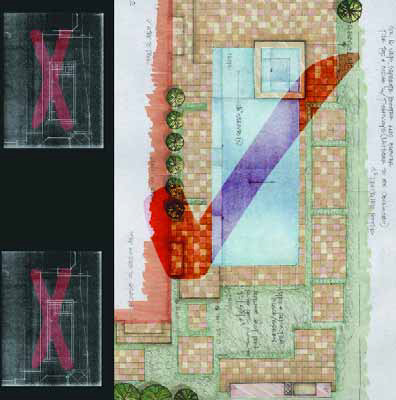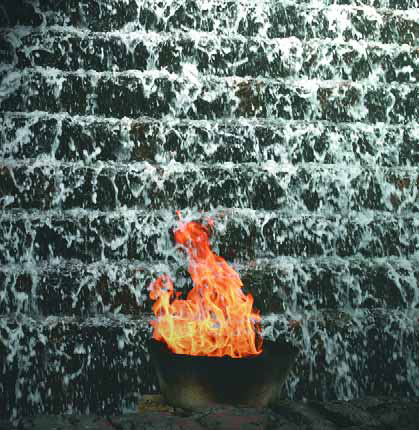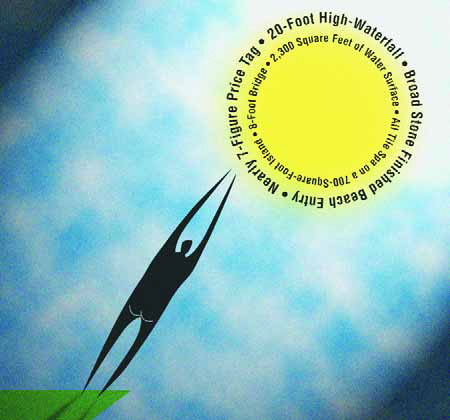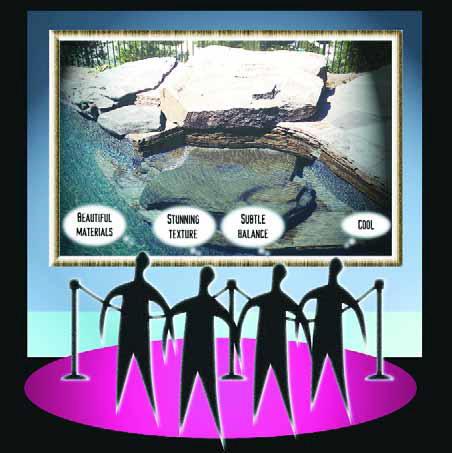presentation
Through the years in these pages and elsewhere, I've been a persistent critic of the shortcomings of the watershaping trades in general - and especially of the pool and spa industry in which I've operated for more than 25 years. Sometimes I've been harsher than others, but my intent has invariably been to define the difference between quality work that elevates the trade and the junk that's held back our industry's reputation. I've never named names, but I've been particularly hard on practitioners who seem eternally stuck in old ways of thinking and working: Their work seldom lines up with the best efforts of which the industry is capable. Just recently, I had a long talk with WaterShapes' editor in which we discussed the development of a new approach to
One of the greatest contrasts I've found between watershapers from the pool and spa industry and watershapers with backgrounds in landscape architecture is the way representatives of the two groups handle their portfolios. Landscape architects are taught that the way they present past work has everything to do with their ability to market their current design services. In the pool/spa industry, by contrast, designs are still rarely paid for and instead are offered as a means to winning a construction contract. In this context, portfolios tend to be far less sophisticated and generally cover examples of the company's work rather than that of an individual designer. That situation is (thank goodness) changing on several fronts, and it seems an opportune time for watershapers in general to step up in sophistication and focus on
It's unfortunate, but all too often watershapers and landscape professionals go to extraordinary lengths in designing and building beautiful spaces - then don't take care of business when it comes to capturing those spaces with quality photographs. This is despite the fact that photography is hugely important to so many of us, if only to give us a worthy photographic record of our work to use in marketing and selling future projects. These images make up our portfolios, dress up our offices and showrooms and serve as
Where you've come from often has everything to do with where you're going. As a case in point, let me describe a project that had its origins all the way back at the very start of my work as a watershaper. My pool industry career began soon after I graduated from college. At the time, I was living in a garage in a rough part of Los Angeles and really wasn't sure what I wanted to do. I had studied ancient history, three-dimensional design and industrial design and had been accepted as a PhD candidate in pharmacology at the University of the Pacific. I was convinced I wanted to be a designer, but I wasn't sure which field I should enter. Then one day, at a time when I was about as broke as an organ grinder without a monkey, I answered an ad in the newspaper looking for
As watershape designs become ever more creative and adventurous, there's an increased need to help clients and other project participants visualize our plans. Indeed, presentation is a topic of great importance these days for designers from both the pool/spa industry and the landscape trades, so much so that it's become a fixture on educational calendars and one of the cornerstones of the Genesis 3 curriculum. What has everyone excited about upgrading the way they present their ideas is that there are various good ways to get the job done. To be sure, having the ability to draw is a tremendous asset - some would say an absolute necessity - but fortunately for those who are
The renovation project I've been discussing for the past couple of issues will be on hold for a few weeks as we await the arrival of a shipment of custom tile from Italy. We'll pick up with that project once work resumes. In the meantime, let's begin coverage of what would have been the next project for "Details" - discussions that will carry us through a good part of the year to come. Everything about this Pennsylvania watershape has been impressive, right from the start. Simply put, it's one of the biggest and most elaborate projects I've ever tackled. As designed, the watershape will
In one way or another, visual acceptance is what makes our world go around. Think about the clothes we wear, the cars we admire, the foods we eat - not to mention interior design, home and office furnishings, landscapes and watershapes. So much of our response to these and other features of our environment is based on the visual. It may sometimes be a shallow response, but human beings tend to like things that look good, even if they don't completely understand why some things are visually appealing and others are not. Design education teaches us that
For many people in the watershaping trades, client relationships begin with selling and never really advance beyond that stage. For me, however, it's not about selling per se; instead, it's about creating a sense of collaboration and building a foundation of mutual trust and understanding. In fact, the work I do in establishing these creative relationships with my clients may well be the most important "detail" of all. In a sense, watershaping isn't a job to me. It's my passion, which explains why I'm so obsessed with
One of the most critical moments in the life of any watershaper occurs when he or she meets prospective clients face to face for the first time. This is when jobs are won or lost - and, more significant, the point at which watershaper and clients begin what can become a long and fruitful relationship. I'll state right up front that I do not approach my initial customer meetings with the idea of walking out with a signed contract and a check. Instead, I go in trying to do what I can to help clients realize their dream of becoming owners of a quality watershape. Whether I end up






















